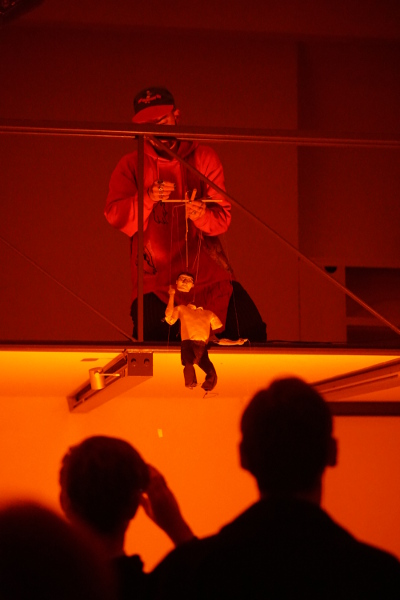Johann Arens invites: Jay Tan, Daniel Lichtman, Jude Crilly & Joseph Noonan-Ganley
During a conversation with Johann Arens we discuss Michel de Certeau. In The Practice of Every Day life (1982), de Certeau’s most quoted work, he attempts to show how people deal with everyday rules and structures. Where power is concerned, in contrast to Michel Foucault, de Certeau focusses not just on disciplinary processes but also sees the surrounding space. He investigates the way in which people resist or protest and consequently change the rules. He describes how they do things just slightly differently than intended, gaining a small amount of freedom for themselves and others. This is in fact the commonality between Arens and the four artists whose work he invited to perform during the opening of Amended Plastics. Like his own, their work slides close along the edge of the normal, looking like what we know, but perverting that reality on behalf of freedom and space.
In the framework of Amended Plastics art has been given no certainties. It is experiment, in the process of becoming. In this, it meets the criteria of PuntWG: a space intended for art to test itself, creating space for content and working processes. Arens creates works bound to their contexts and the emphasis that he places on the human body was also evident in the performances during the opening event:
On seeing the marionette that brings life to Jay Tan’s performance – a sound recording with instructions for relaxation exercises: breathe in, breathe out, make the blue light warm and red – I was reminded of Alfred Jarry, who in 1896 performed the play Ubu Roi with marionettes. ‘For a relatively small audience’, noted his biographer, Alistair Brotchie. We breathe in and we breathe out, and we have been part of something special.
Jude Crilly presented a text composed of fragments, coupled with music and sound. It is not often that I listen to bare sound, without images. The performance is impressive: young girls, going out on the town, the desire to remain physically young, perverted. Where Crilly speaks of youth, Daniel Lichtman’s Doctors and Nurses deals with age. An actor (James Frieman) is talking about an open heart surgery. H (age), says the woman (Lara Allen). She is not listening. She is consumed by her own lines and experiences. In the background a red leather couch, a black-and-white chequered floor, a TV and a plant. The work has overpowering force, thanks to the exaggerated behaviour of the actors, hard contrasts and intermittent blurriness of the image.
Finally, Joseph Noonan-Ganley presented a film to a background of an interview with fashion designer Charles James, who talks about his ideas. His fairytale-perfect dresses, moulded around the body, touch ever-so-lightly and seemingly by accident on erotic memories and physical details. The film is a psychological-historical reconstruction of the evolution of an iconic piece of clothing, the first zippered dress. The art is toying, as if in the process of sketching, with the closed and compelling images of fashion, television and film.
At puntWG, Johann Arens’ work becomes the scene framing the events. He presents a film made during his stay at the Asia Culture Center in Gwangju, Korea. It shows a series of sculptures made of remnants from a prosthetic manufacture set against a background of an empty office interior. Still packed in plastic, these interiors question our physical presence. The chairs with stiff fabrics, the armrests and supports made of bent plastic, they seem to restrict the needs of our bodies. They shape them and coerce them to work. With their broken forms, the sculptures force us to rethink our standardised work environments.
On view, Johann Arens amanded plastics, PuntWG 17.12.2017



